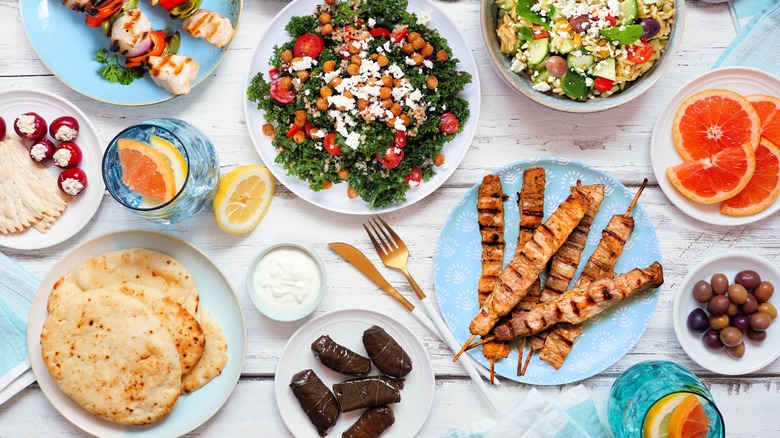Yotam Ottolenghi's Ideal Last Meal Is An Endless Spread Of Mediterranean Classics
Warm, freshly made hummus with wood-fired pita bread. Herbed olives. Greek moussaka. Crunchy, flaky spanakopita and baklava. Mediterranean Greek food is absolutely dreamy, especially when served along the pristine seaside of where it originates from. And for Israeli-born British Chef Yotam Ottolenghi, he would choose this exact setup for his last meal.
The chef, restaurateur, and cookbook author shared details in his column in The Guardian about where he would want his last meal to take place, and what it would be comprised of. For starters, he would want to be on the small teardrop-shaped Greek island of Kea — one hour from Athens by ferry — surrounded by friends and family. A beach shack would supply morning mojitos and a leisurely feast would follow after, where Ottolenghi would rather leave the cooking to a local chef for a more hands-off day.
Now the important part, the food: Ottolenghi would prefer a table filled with Greek meze for his last meal. There would be small plates of grilled lamb cutlets marinated in citrus and herbs, and a grilled octopus salad featuring capers, celery, paprika, and lemon. The chef is known for his Middle Eastern and Mediterranean vegetable-forward dishes, especially those that feature roasted eggplants with the perfect texture. Naturally, his last meal would include dishes like garlicky aubergine with tahini sauce, along with beet-infused yogurt, roasted red peppers with feta, and a fava puree made from yellow split peas. There would be a generous serving of fried calamari, followed by white peaches with cream for dessert.
What is a Greek meze?
What chef Yotam Ottolenghi has described as his perfect last meal is what is essentially considered to be a Greek meze, which involves sharing a variety of small plates with drinks over lively conversation. Meze can be thought of as an appetizer or a light meal, and normally takes place before dinner — similar to the tradition of apertivo time in Italy. While food is important here, the main focus is connection and community.
Many of the dishes that the chef mentioned are typical at a meze table, where normally a mix of hot and cold snacks are served up. They could be something as simple as tomatoes and feta, or more complex dishes like moussaka — a layered dish with eggplant, tomato, béchamel sauce, and sometimes beef. Dips like hummus, tzatziki, and taramosalata (fish roe) are always popular, as are Greek salads. Smoked fish and seafood, seasoned sausages, pita, and halloumi (not to be confused with panner) as well as fresh goat's cheese are standard components of the spread as well.
A key part of the meze table is ouzo, an anise-flavored Greek aperitif meant to stimulate the appetite. Ottolenghi said he would want plenty of this flowing during the meal, after an evening of drinking Campari, an Italian aperitif, while watching the sunset. After the drinks and savory eats, it's customary to end the meze on a sweet note. Greek coffee, which is similar to Turkish coffee, or a liqueur is served up alongside a dessert like baklava.

